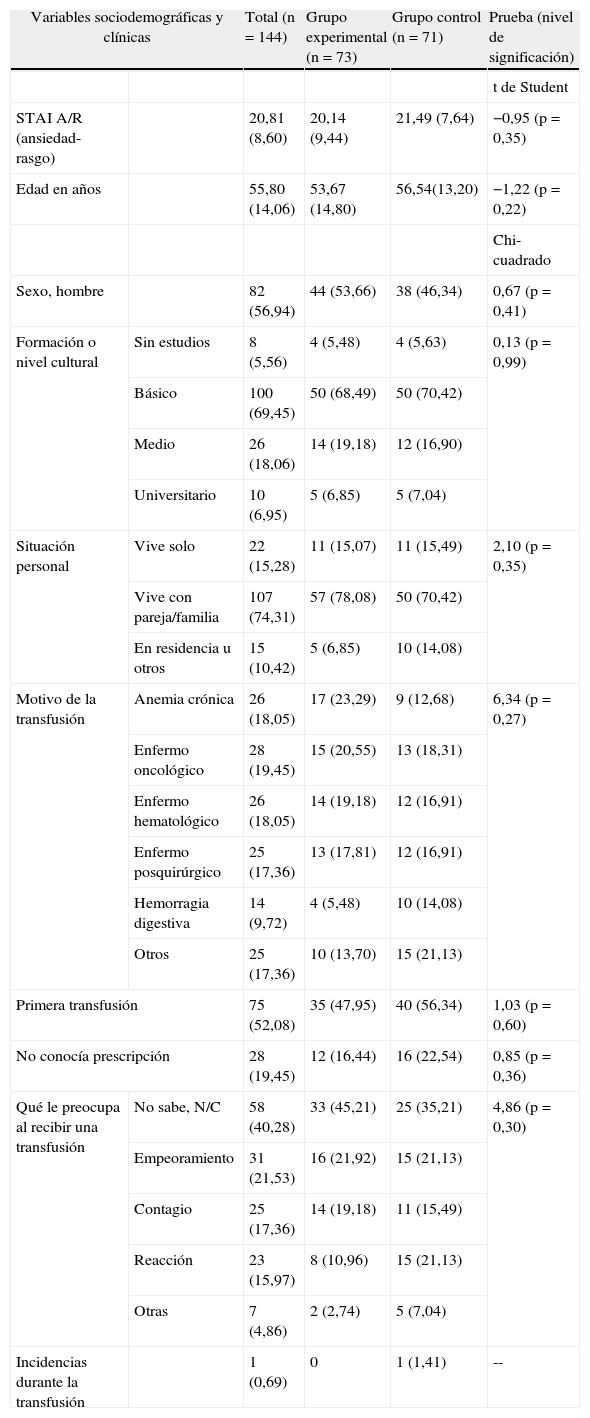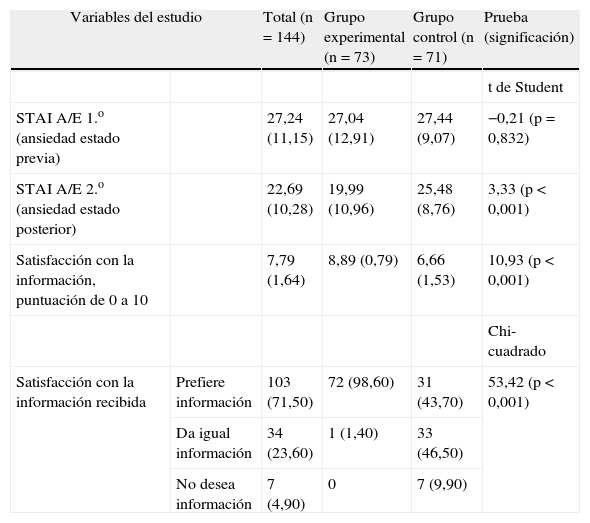Evaluar la efectividad de una intervención educativa sobre la ansiedad y la satisfacción en pacientes con indicación de transfusión de hematíes.
MétodoEnsayo clínico aleatorizado, controlado, simple ciego, en pacientes con indicación de transfusión de concentrado de hematíes.
Tamaño muestralAlfa 0,05, beta 0,10, diferencia a detectar 10%, 70 sujetos en cada grupo. Muestreo por reclutamiento con asignación aleatoria a grupo intervención (GI) y control (GC). Variables independientes: intervención protocolizada en GI mediante información oral y escrita sobre seguridad, riesgos y beneficios de la hemoterapia mediante guía editada; la del GC será equivalente sobre temas de salud general. Variables dependientes: ansiedad-estado preintervención y postintervención; cuestionario validado de Spielberger: STAI. Satisfacción, cuestionario ad hoc. Variables sociodemográficas y clínicas: filiación, motivo de transfusión, conocimiento de la prescripción, incidencias, antecedentes.
ResultadosCiento cuarenta y cuatro sujetos, 73 (50,69%) en GI y 71 (49,31%) en GC. Edad media 55,80 años, sexo masculino 56,94%, primera transfusión 52,08%. Comparabilidad entre GI y GC comprobada y ratificada. Tras la intervención la ansiedad disminuyó, siendo en GI de 19,99, frente a 25,48 en GC; la diferencia fue muy superior al 10% propuesto y estadísticamente significativa. La preferencia por la información fue del 98,60% en GI, frente al 43,70% en GC.
ConclusionesSe confirma nuestra hipótesis; una intervención educativa enfermera protocolizada aumenta la satisfacción del paciente con los cuidados de enfermería y disminuye su ansiedad, con lo que previene complicaciones y ofrece a los usuarios una mayor seguridad.
To evaluate the effectiveness of an educational intervention regarding anxiety and satisfaction in patients requiring a red blood cell transfusion.
MethodRandomised, controlled, single-blind clinical trial in patients requiring a packed red blood cell transfusion. Sample size: alpha=.05, beta=.10, to detect a 10% difference, 70 subjects in each group. The sampling recruitment was randomised to the intervention group (IG) and the control group (CG). Independent variables: an intervention protocol with oral and written information using a published guide on the safety, risks and benefits of haemotherapy for the IG, and an equivalent one on general health topics for the CG. Dependent variables: pre- and post-anxiety state; Spielberger's validated questionnaire: STAI. Satisfaction, by an ad hoc questionnaire. Sociodemographic and clinical variables: description, reason for transfusion, prescription knowledge, incidents, records.
ResultsThere was a total of 144 subjects, 73 (50.69%) in the IG, and 71 (49.31%) in the CG. The mean age was 55.80 years, with 56.94% males, and a first transfusion in 52.08%. Comparability between the IG and the CG was tested and confirmed.
The decrease in anxiety after the intervention for the IG was 19.99, compared to 25.48 in CG. The difference was greater than the proposed 10%, and was statistically significant. The preference for information was 98.60% in IG, compared to 43.70% in CG.
ConclusionsThe hypothesis was confirmed; a protocolised nursing educational intervention protocol increased patient satisfaction with nursing care, and decreased patient anxiety, thus preventing complications and providing greater safety to the users.
Artículo
Comprando el artículo el PDF del mismo podrá ser descargado
Precio 19,34 €
Comprar ahora








